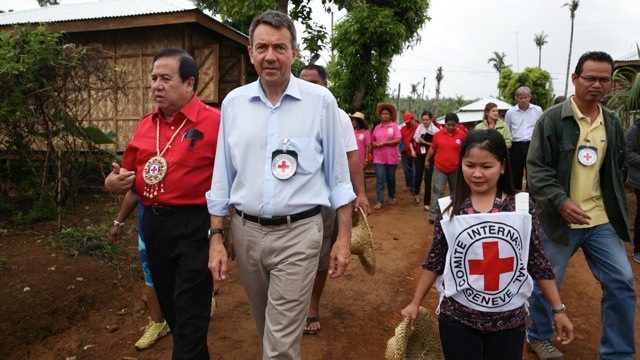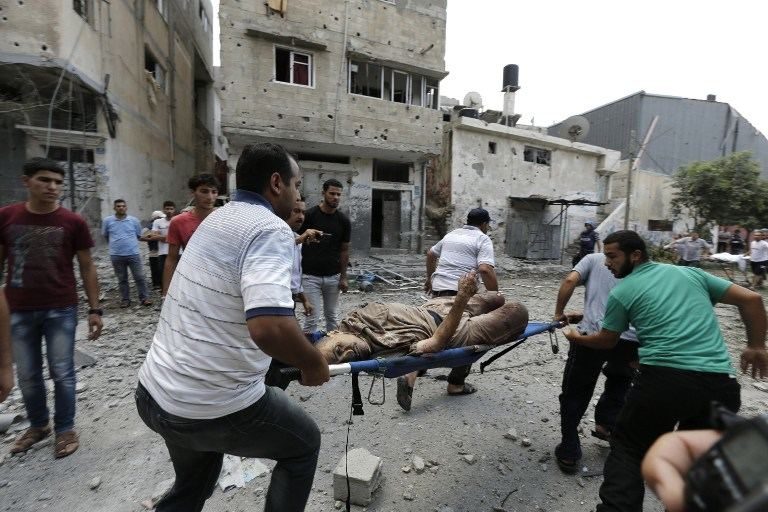SUMMARY
This is AI generated summarization, which may have errors. For context, always refer to the full article.

MANILA, Philippines – When government troops and rebel fighters of the Moro National Liberation Front (MNLF) clashed in Zamboanga City in early September of 2013, at least 11 Red Cross volunteers were injured from a grenade explosion. This incident, when compared to other similar incidents globally, was a relatively minor one.
In conflict zones around the world, it is becoming increasingly risky to be a humanitarian aid worker, many of whom work at the front lines caring for the sick and injured. In 2014 alone, at least two humanitarian workers have been killed and countless more put in harm’s way despite the protection accorded to them by international humanitarian law. (READ: What’s it like to be a humanitarian worker?)

“We see increased deliberate targeting of humanitarian workers using methods of terror towards the civilian population, towards humanitarian [workers] and this of course challenges us to the utmost,” Peter Maurer, International Committee of the Red Cross (ICRC) president, said in an interview with Rappler. Maurer was in the Philippines from August 26 to 28 in his first official visit as the head of the ICRC. (READ: Protect the humanitarian workers)
He added that the ICRC and other global humanitarian agencies face new challenges in delivering aid as a result of conflicts spreading beyond national borders. “In the past we had the tendency to look at the program in Iraq and the program in Syria and the program in Lebanon. Today, it’s just a program in the Middle East because challenges have caught across borders.”
Maurer also said the “politicization of humanitarian activity” was another challenge for the ICRC. He cited as examples the potential conflicts of interest when states co-opt humanitarian organizations or engage in humanitarian actions to foster their own political agendas.
In September, Russia’s decision to push ahead with its humanitarian convoy into eastern Ukraine without official endorsement from the ICRC caused a stir in the international community, with many suspecting the convoy was a ploy to gain access to pro-Russian rebel-held territory.
The ICRC and national Red Cross organizations are supposed to maintain their independence, impartiality, and neutrality. In practice, however, some national Red Cross organizations are directly state-sponsored and organized.

Changing dynamic
Founded in 1863, the ICRC is mandated by international law to protect combatants of international and internal armed conflicts. Today, the mandate has evolved to include protection of the victims of war, such as prisoners, refugees, and other non-combatants.
In the Philippines, the ICRC and its affiliated organization, the Philippine Red Cross (PRC), has been aiding people displaced by the internal armed conflicts in the country, including in the 2013 hostilities in Zamboanga where thousands are still living without permanent homes.
The ICRC also visits people detained in relation to the armed conflict to ensure proper treatment and living conditions. The conduct follow-up visits to the 280 people detained in relation to the Zamboanga conflict, and provide support to families so they could visit their detained relatives.
After Super Typhoon Haiyan (Yolanda) hit the country in November 2013, the ICRC and 150 national Red Cross and Red Crescent societies from different parts of the world provided temporary shelter, food, and medical assistance to thousands of survivors.
“I have seen many other areas of need and conflict and humanitarian needs worldwide and I was impressed by what has been achieved,” Maurer said of his visit to Samar Island where he assessed rebuilding efforts supported by the ICRC and the PRC.
Preparedness over mitigation
Disaster response is a relatively recent role of the ICRC, which has traditionally focused on the response to violent conflicts. Maurer observed that with the increased frequency of natural disasters, the international community should review existing policies and structures “in order to respond to what we all think will be a likely pattern of humanitarian challenges in the future – more frequent, more deep natural disasters – in addition to armed conflict.” Maurer added that the challenge is to evolve from mitigating the effects of disasters to better disaster preparedness.
Maurer also met with President Benigno Aquino III to call attention to the plight of Haiyan survivors, the Zamboanga IDPs and the overcrowding of the country’s prison cells. He noted that while progress has been made to address these issues, “a lot still has to be done.” Maurer called for another “energizing response” from the Philippine government, the Philippine Red Cross, and the international movement, particularly for the survivors of typhoon Haiyan. – Rappler.com
Add a comment
How does this make you feel?
There are no comments yet. Add your comment to start the conversation.